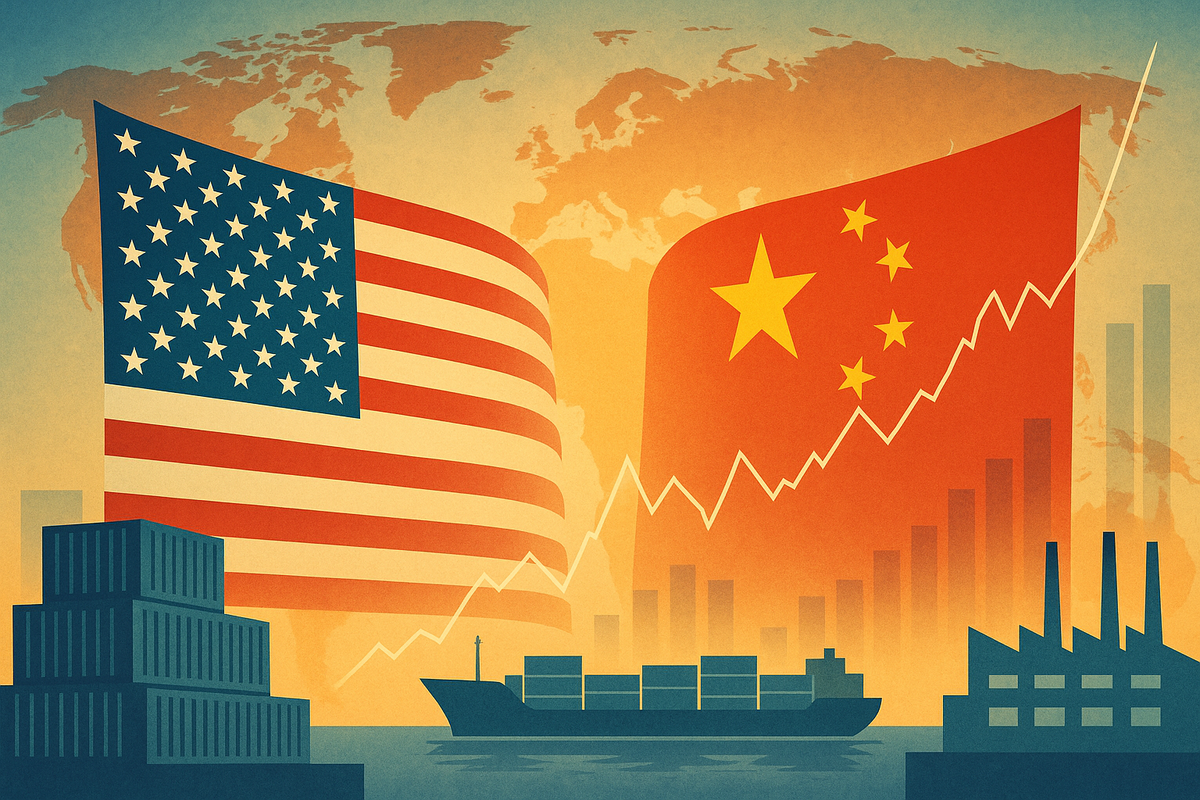
Global financial markets have breathed a collective sigh of relief following President Donald Trump's decision to extend the imposition of higher tariffs on Chinese goods for another 90 days. This eleventh-hour reprieve, announced just as the previous agreement was set to expire, has averted a significant escalation of the trade war between the world's two largest economies, injecting a fresh wave of optimism into investor sentiment and fueling a notable market rally.
The extension provides a crucial window for continued negotiations, easing immediate anxieties over a potential full-blown tariff conflict that threatened to disrupt global supply chains and dampen economic growth. This move has been widely interpreted as a positive step towards de-escalation, allowing businesses and consumers to navigate the critical year-end holiday season without the immediate burden of drastically increased import costs.
A Crucial Pause in the Trade War Escalation
President Trump's decision to extend the U.S.-China trade truce for 90 days, announced in August 2025, was a pivotal moment that prevented a significant escalation of tariffs. Had the extension not occurred, U.S. tariffs on Chinese goods were poised to skyrocket, potentially reaching as high as 245% from their existing baseline rates of 30%. In retaliation, China had threatened to impose tariffs of 125% on U.S. goods, up from their current 10%. This looming threat of a drastic increase in trade barriers had cast a long shadow over global markets, creating immense uncertainty for businesses and investors alike.
The timeline leading up to this decision was fraught with tension. The initial 90-day truce, agreed upon earlier in the year, was nearing its expiration, with little public indication of a breakthrough in negotiations. As the deadline approached, market anxiety intensified, with many fearing a return to aggressive tariff hikes. President Trump's announcement, made just hours before the previous agreement was set to lapse, came as a welcome surprise to many, signaling a willingness from both sides to continue dialogue rather than resort to immediate punitive measures.
Key players involved in these high-stakes negotiations include President Trump and his administration's trade representatives, particularly U.S. Trade Representative Robert Lighthizer and Treasury Secretary Steven Mnuchin, on the U.S. side. Their Chinese counterparts include President Xi Jinping and his top economic advisors. These individuals have been at the forefront of discussions aimed at addressing long-standing U.S. concerns regarding intellectual property theft, forced technology transfer, market access, and China's industrial subsidies.
Initial market reactions were overwhelmingly positive. Global stock markets surged immediately following the announcement. Asian markets led the charge, with Japan's Nikkei 225 hitting an all-time high, rising 2.5%, and Australia's ASX 200 (ASX:XJO) also reaching a new record, closing up 0.41%. European markets followed suit, with the UK's FTSE 100 (LSE:UKX) index closing up 0.2% and the French Cac 40 (EPA:PX1) rising 0.5%. In the U.S., the S&P 500 (NYSEARCA:SPY) rose 0.9% in early trading, the Dow Jones Industrial Average (NYSEARCA:DIA) was up 1%, and the tech-focused Nasdaq Composite (NASDAQ: QQQ) climbed 1.1%, all heading towards record highs. This widespread rally underscored the market's relief and optimism that a full-blown trade war had been temporarily averted, providing a much-needed period of stability.
Winners and Losers in the Extended Truce
The 90-day extension of the U.S.-China trade truce, while a broad positive for market stability, creates a nuanced landscape of winners and those still facing significant headwinds. The primary beneficiaries are companies and sectors that rely heavily on stable supply chains and predictable trade policies, as the extension prevents a sharp increase in costs and disruptions.
Retailers and consumer goods companies stand out as major winners. The prevention of a massive increase in tariffs on Chinese imports directly translates to avoiding higher prices for U.S. consumers and averting severe supply chain disruptions, particularly crucial as businesses prepare for the critical year-end holiday season. The American Apparel & Footwear Association (AAFA) has been vocal in welcoming this pause, emphasizing that higher tariffs would have led to "devastating consequences like product elimination and business closures" for their sector.
Technology giants and companies with extensive global supply chains also benefit significantly. Firms like Apple Inc. (NASDAQ: AAPL), which assembles its iPhones in China, have historically been vulnerable to tariff threats. This truce extension helps Apple avoid further price hikes or supply chain issues that could impact its profitability and consumer demand. Similarly, semiconductor companies such as Nvidia (NASDAQ: NVDA) and AMD (NASDAQ: AMD), despite ongoing tensions regarding technology transfer, gain from the broader market stability. Recent deals allowing these companies to continue selling certain advanced chips to China, in exchange for a portion of their revenue, highlight a complex but ongoing trade relationship that thrives on a truce rather than escalation. The extension also includes China suspending non-tariff measures against some U.S. companies on its export control list, potentially benefiting defense contractors like Lockheed Martin (NYSE: LMT) and Boeing Defense (NYSE: BA) by allowing them to continue selling dual-use goods. The automotive industry, including Tesla Inc. (NASDAQ: TSLA), also benefits from the prevention of further tariff escalation on U.S.-made automobiles, which had previously seen Chinese retaliatory tariffs rise significantly.
However, despite the truce, several sectors and companies continue to face challenges due to existing tariffs, unresolved structural issues, or the lingering uncertainty of a prolonged, unresolved trade dispute. U.S. agricultural exporters remain significantly impacted. Existing tariffs continue to affect their profitability and market access, with China's agricultural imports from the U.S. seeing substantial declines. Soybean imports, for instance, have been particularly hard hit, falling from $17.9 billion in 2022 to just $2.5 billion in January-June 2025. Companies like Archer-Daniels-Midland Company (NYSE: ADM) (soybeans) and Tyson Foods, Inc. (NYSE: TSN) (pork) will continue to navigate these challenges.
Furthermore, companies that have already invested heavily in diversifying their supply chains away from China, relocating manufacturing facilities to countries like Vietnam, Mexico, or Taiwan, might see a slower return on these investments if the truce holds and the urgency to diversify diminishes. Sectors facing persistent non-tariff barriers, such as medical devices and pharmaceuticals, will also continue to face cost pressures and challenges due to Chinese procurement rules that favor local production, as the truce primarily addresses tariffs but leaves fundamental issues like intellectual property rights and state subsidies unresolved. While the extension prevents higher prices, U.S. consumers are still indirectly absorbing a portion of the existing 30% tariffs on Chinese imports, with Goldman Sachs strategists estimating that consumers have absorbed 22% of these costs through June 2025.
Industry Impact and Broader Implications
The extended U.S.-China trade truce, while offering a temporary calm, underscores a broader and more enduring trend of increasing economic nationalism and protectionist sentiments across the globe. This pause in tariff escalation is not an end to the trade war but rather a tactical maneuver, allowing industries to recalibrate and adapt to a new normal characterized by heightened geopolitical risk in supply chain management. A significant implication is the accelerated diversification of global supply chains. Companies, particularly those heavily reliant on Chinese manufacturing, are actively exploring and shifting portions of their production to alternative hubs such as Vietnam, India, and Mexico. This "China+1" strategy aims to build more resilient and diversified supply chains, reducing dependency and exposure to future tariff shocks and geopolitical uncertainties. This strategic pivot will have long-term ripple effects on global logistics, infrastructure development in emerging markets, and the competitive landscape for contract manufacturers.
The truce creates a mixed bag of fortunes for various countries and companies. Countries like Vietnam, Mexico, and Taiwan, which have benefited from trade diversion as companies sought alternatives to China during the trade war, might see a reduction in new business opportunities if a more permanent resolution were to emerge. However, if the underlying uncertainty persists, the trend of supply chain diversification will continue to accelerate, potentially benefiting these alternative manufacturing hubs. Companies heavily reliant on global supply chains, especially those with significant manufacturing or sourcing from China, are primary beneficiaries of the extension, as it averts immediate tariff escalations and provides crucial breathing room for planning, recalibrating procurement schedules, and adjusting inventories. China's strategic control over critical minerals, particularly rare earths, has proven to be a significant bargaining chip in trade talks. The U.S. has agreed to reduce restrictions on exports of computer chip technology and ethane for petrochemical production, while China committed to improving U.S. companies' access to rare earth materials. This highlights how China can exert economic pressure on the U.S. and its allies by weaponizing its control over key supply chains.
The ongoing negotiations extend far beyond mere tariffs, delving into fundamental and complex structural issues. Key issues on the table include intellectual property rights, forced technology transfer, state subsidies, market access, fentanyl flows, rare-earth controls, and tech export curbs, particularly on advanced AI chips. The truce provides more time for productive discussions on these sensitive matters. The U.S.-China trade relationship has entered a state of "managed hostility," where both economies benefit from the global framework but strategic competition persists. A novel approach observed is the "monetization of trade policy," where the U.S. has allowed companies like Nvidia (NASDAQ: NVDA) and AMD (NASDAQ: AMD) to sell advanced AI chips to China, with the unusual stipulation that a portion of the sales revenue (e.g., 15%) be handed over to the U.S. government. Both nations are also ramping up investment in self-sufficiency. The U.S. is pushing the CHIPS and Science Act to boost domestic semiconductor production, while China is doubling down on its Made in China 2025 strategy to reduce reliance on Western technology.
Historically, trade disputes between major economic powers have often been protracted and complex, with resolutions taking years to materialize. The current situation bears some resemblance to past trade frictions, such as the U.S.-Japan trade disputes in the 1980s, which also involved accusations of unfair trade practices and market access issues. Another historical parallel is the Smoot-Hawley Tariff Act of 1930, which is often cited as a "beggar-thy-neighbor" policy that contributed to deepening the Great Depression, serving as a cautionary tale against protectionist measures. The current U.S. average tariff rate, at 18.6%, is the highest since 1933, reflecting a significant shift towards protectionism. While the truce offers temporary stability, the prolonged uncertainty still creates a challenging environment for long-term strategic planning for businesses. The outcome of these discussions could set new precedents for international trade agreements and influence how countries approach bilateral and multilateral trade relations in the future.
What Comes Next
The 90-day extension of the U.S.-China trade truce, while a welcome reprieve, sets the stage for a complex and evolving landscape in global trade. The immediate impact is a temporary calm for global supply chains, particularly beneficial for businesses preparing for the critical holiday trade season. Negotiations are expected to continue, focusing on issues such as trade imbalances, market access for U.S. exporters, lifting trade restrictions, and stabilizing the global semiconductor supply chain. However, analysts suggest that significant breakthroughs are unlikely in the immediate future, with "piecemeal agreements" on specific issues like export controls and goods purchases being more probable.
In the long term, the deeper reality of the U.S.-China trade relationship is characterized by "managed hostility" and persistent strategic competition. Experts anticipate that the "trade war will continue grinding ahead for years into the future," with a trend towards further economic decoupling in critical sectors. China is actively diversifying its trade dependencies, reducing reliance on the U.S. market, and investing in self-reliance for critical technologies. The U.S., conversely, is signaling a strategy of drawing a "line" between economic interests and strategic competition, aiming to ramp up business in less advanced products and technologies while restricting access to cutting-edge advancements.
For businesses, strategic pivots are essential. Companies are increasingly adopting diversified supply chain strategies, moving beyond "China +1" to "China + many," spreading risk across multiple geographies like Vietnam, India, and Mexico. Nearshoring and reshoring initiatives are gaining traction to improve resilience and reduce lead times. Businesses are also evaluating their cost structures, adjusting pricing strategies, and exploring mechanisms like tariff exemptions and duty drawback programs to mitigate the impact of existing tariffs. Investment in supply chain technology and strengthening supplier relationships are also crucial adaptations. Technology companies, in particular, must closely monitor export controls and intellectual property developments, adapting their research and development strategies accordingly. For governments, the U.S. administration continues to use tariffs as leverage to address perceived unfair trade practices, intellectual property theft, and national security concerns, while China is responding by accelerating technological innovation to achieve self-sufficiency and exploring new export markets to reduce dependence on the U.S.
Conclusion
The extended U.S.-China trade truce represents a fragile calm in a protracted economic conflict. The key takeaway is that while an immediate escalation of tariffs has been averted, the underlying structural issues and strategic competition between the two economic superpowers remain unresolved. This temporary reprieve offers short-term stability to global markets and businesses, allowing for continued dialogue and providing a crucial window for companies to adapt their supply chain strategies.
Moving forward, the market will likely operate under a cloud of "managed hostility," where both economies benefit from the global framework but strategic competition persists. Investors should watch for further "piecemeal agreements" on specific trade issues rather than anticipating a grand bargain that resolves all disputes. The trend of economic decoupling, particularly in critical sectors like semiconductors and rare earths, is expected to accelerate, leading to more diversified global supply chains.
The lasting impact of this truce will be its role in shaping how businesses approach global trade and risk management. Companies that proactively diversify their supply chains, invest in resilient operations, and adapt to evolving regulatory landscapes will be better positioned to navigate the ongoing uncertainties. While the immediate threat of higher tariffs has receded, the fundamental tensions between the U.S. and China are expected to persist, ensuring that the path forward for global trade remains complex and requires continuous vigilance from investors and businesses alike.




